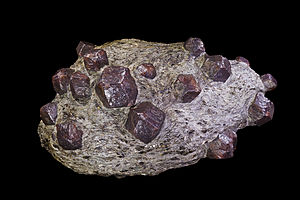
Back Almandiet Afrikaans Almandín AN ألمندين Arabic Granate Almandinu AST Almandin Azerbaijani Альмандын Byelorussian Альмандын BE-X-OLD Алмандин Bulgarian Almandina Catalan Almandin Czech
| Almandine | |
|---|---|
 | |
| General | |
| Category | Nesosilicate |
| Formula (repeating unit) | Fe2+ 3Al 2Si 3O 12 |
| IMA symbol | Alm[1] |
| Strunz classification | 9.AD.25 |
| Crystal system | Cubic |
| Crystal class | Hexoctahedral (m3m) H–M symbol: (4/m 3 2/m) |
| Space group | Ia3d |
| Identification | |
| Color | reddish orange to red, slightly purplish red to reddish purple and usually dark in tone |
| Cleavage | none |
| Fracture | conchoidal[2] |
| Mohs scale hardness | 7.0–7.5 |
| Luster | greasy to vitreous |
| Streak | white |
| Specific gravity | 4.05+0.25 −0.12[2] |
| Polish luster | vitreous to subadamantine[2] |
| Optical properties | Single refractive, and often anomalous double refractive[2] |
| Refractive index | 1.790±0.030[2] |
| Birefringence | none |
| Pleochroism | none |
| Dispersion | 0.024[2] |
| Ultraviolet fluorescence | inert |
| Absorption spectra | usually at 504, 520, and 573 nm, may also have faint lines at 423, 460, 610 and 680–690 nm[2] |
| References | [3][4][5] |
Almandine (/ˈælməndɪn/), also known as almandite, is a species of mineral belonging to the garnet group. The name is a corruption of alabandicus, which is the name applied by Pliny the Elder to a stone found or worked at Alabanda, a town in Caria in Asia Minor. Almandine is an iron alumina garnet, of deep red color, inclining to purple. It is frequently cut with a convex face, or en cabochon, and is then known as carbuncle. Viewed through the spectroscope in a strong light, it generally shows three characteristic absorption bands.[6]
Almandine is one end-member of a mineral solid solution series, with the other end member being the garnet pyrope. The almandine crystal formula is: Fe3Al2(SiO4)3. Magnesium substitutes for the iron with increasingly pyrope-rich composition.
Almandine, Fe2+
3Al
2Si
3O
12, is the ferrous iron end member of the class of garnet minerals representing an important group of rock-forming silicates, which are the main constituents of the Earth's crust, upper mantle and transition zone. Almandine crystallizes in the cubic space group Ia3d, with unit-cell parameter a ≈ 11.512 Å at 100 K.[7]
Almandine is antiferromagnetic with the Néel temperature of 7.5 K. It contains two equivalent magnetic sublattices.[8]
- ^ Warr, L.N. (2021). "IMA–CNMNC approved mineral symbols". Mineralogical Magazine. 85 (3): 291–320. Bibcode:2021MinM...85..291W. doi:10.1180/mgm.2021.43. S2CID 235729616.
- ^ a b c d e f g Gemological Institute of America, GIA Gem Reference Guide 1995, ISBN 0-87311-019-6
- ^ Mindat.org - Almandine
- ^ Webmineral.com - Almandine
- ^ "Handbook of Mineralogy - Almandine" (PDF). Archived from the original (PDF) on 2016-03-03. Retrieved 2013-03-01.
- ^ One or more of the preceding sentences incorporates text from a publication now in the public domain: Chisholm, Hugh, ed. (1911). "Almandine". Encyclopædia Britannica. Vol. 1 (11th ed.). Cambridge University Press. p. 712.
- ^ Geiger, C.; Armbruster, Th.; Lager, G.; Jiang, K.; Lottermoser, W.; Amthauer, G. (1992). "A combined temperature dependent 57Fe Mössbauer and single crystal X-ray diffraction study of synthetic almandine: evidence for the Gol'danskii–Karyagin effect". Physics and Chemistry of Minerals. 19 (2): 121–126. doi:10.1007/BF00198609. S2CID 98610041.
- ^ Zherebetskyy, Danylo (2010). Quantum mechanical first principles calculations of the electronic and magnetic structure of Fe-bearing rock-forming silicates (PhD). Dissertation.com, Boca Raton, Florida. ISBN 978-1-59942-316-6.
© MMXXIII Rich X Search. We shall prevail. All rights reserved. Rich X Search